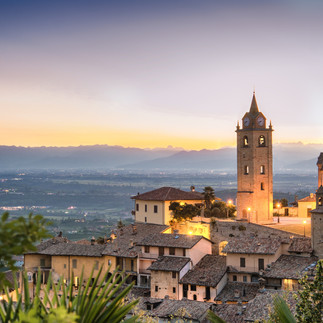Agnolotti al plin
- marinatotta

- Oct 25, 2021
- 5 min read
Updated: Aug 7, 2025

Agnolotti is predominately from the Langhe, a hilly area in the region of Piedmont, famous for Barolo wine and white truffles.
The pasta is a square-shaped ravioli with ruffled edges, sealed with a pinch, which the word 'plin' means in the local dialect. They are lavishly stuffed with leftover braised meat — usually veal, pork, and rabbit — to which spinach or cooked risotto is often added.
I think that to perfect Agnolotti al Plin, it is crucial to seal and pinch 'plin' very carefully, making sure all the juices and the gravy from the braised meat stay inside. After you cook them, the warm juices should burst from the casing and onto your palette.
Traditionally they are made on a Monday to use the leftover meat from a Sunday roast. They are dressed in a glossy and rich gravy made with butter and juices from the braised meat. During the white truffle season, a grating of truffle is added.
We cannot talk about agnolotti al plin without mentioning Guido and Lidia Alciati. In their old restaurant Guido in Costigliole d'Asti, they made these divine little packets by the thousands, week after week, for more than 40 years.
Nowadays, their restaurant — Guido, a one Michelin star, is run by their son Ugo that continues to offer excellent Piedmontese cuisine in the splendid setting of the 19C Villa Reale Fontanafredda in Serralunga d'Alba.
Serralunga D'Alba and Monforte D'Alba, two beautiful little towns around Langhe.
Back home in Melbourne, the only way to eat agnolotti is to make them yourself or to pay a visit to Pentolina in the CBD or Park Street Pasta and Wine in Middle Park.
AGNOLOTTI AL PLIN WITH A GLOSSY GRAVY: RECIPE
Makes 4 serves
Filling:
1 Tbs butter
2 Tbs olive oil
1 medium brown onion, cut in large pieces
1 stalk celery, cut in large pieces
1 carrot, cut in large pieces
2 sprigs rosemary
300g pork shoulder, cut into 5 cm cubes
300g veal or beef shoulder, cut into 5 cm cubes
300g rabbit leg or 300g boned chicken thighs
½ glass white wine
Salt & Black pepper
1 small bunch of spinach
¼ cup freshly grated Parmigiano Reggiano
Freshly grated nutmeg
1 egg, beaten
Pasta Dough:
200g 00 flour
6 egg yolks
2 Tbs olive oil
To serve:
4 Tbs butter
The gravy reserved from the braised meat
Parmigiano Reggiano (optional)
Equipment needed:
Wooden board, Dutch oven, food processor or meat grinder, pasta machine, fluted ravioli cutter.
Making the filling
Prepare the filling a day ahead to let all the flavours combine together.
Heat the oven to 180 degrees. Heat the butter and olive oil in a Dutch oven over medium heat. Add the onion, celery, carrot and rosemary. Cook until soft and browned, about 7 minutes. Remove to a bowl. Add the meat to the pan, in batches, and brown on both sides.
Return the vegetables and all of the meat to the Dutch oven and season the meat with 1 teaspoon of salt. Add the wine, let it bubble for a few minutes. Cover the pan and place in the oven. Roast 30 minutes. Turn the meat over, and, if the pan looks too dry, add a little water. Roast until the meat is very tender, 30 minutes.
Remove the pan from the oven and discard the rosemary and bones. Place the 1/3 of the meat in a bowl with half the vegetables. Enjoy the roast for dinner or freeze it for another use.
Reserve the juices for the pasta sauce.
Blanch the spinach, squeeze out the excess liquid, and add to the meat and vegetables in the bowl.
Pass the meat and vegetables through a meat grinder or food grinder attachment fitted to a mixer (the holes should be about the diameter of a pencil). Place in a bowl. Let cool slightly, then combine with the Parmesan, salt and pepper to taste, nutmeg and the beaten egg.
Rest in the fridge till needed.
Making the dough
Place the flour onto your board. Use your fingers or a bowl to make a well in the centre. Pour the egg yolks and the olive oil in the center. Take a fork and scramble the eggs. Combine eggs with flour using a fork from the middle outwards. With your hands, gradually incorporate the flour from the outside of the well toward the centre, kneading gently until the mass of dough comes together.
Knead the dough until it is smooth and resilient. You may need to add more flour, or you may not be able to incorporate all of the flour, depending on the humidity and the size of the eggs. If the dough is sticky or extremely pliable, knead more flour in.
Work the mass of dough for about 10-15 minutes or until it is smooth and elastic.
Wrap it and place in the fridge to rest for at least half an hour before using.
Rolling and shaping agnolotti
After the resting time, dust the work surface with some extra flour, take 1/3 of the dough and press it out flat with your fingertips.
Roll the dough with a pasta machine.
Cut the pasta strip in half crosswise and cover one piece with plastic wrap. Lay the other on a lightly floured wooden board in front of you.
To fill the pasta, place as many teaspoons of the filling along the lower half of your sheet as you can fit, while also allowing about 0.5 cm between them. Fold the sheet over the filling lengthwise. Press down along the back edge with the side of your thumb to seal. Pinch the pasta between each pocket of filling, thumbs in front, index fingers behind. Don’t press down.
With a ravioli cutter, cut around the pasta to form a decorative edge, then cut between the pockets of filling, always front to back, to form the agnolotti. Each raviolo should be 2-3 cm.
Place the pasta on a baking sheet lined with a tea towel sprinkled with flour. Repeat with the remaining pasta.
Cooking Agnolotti
Bring a large pot of water to boil. Add salt.
Cook the agnolotti until al dente, 3-4 minutes. Drain.
Heat the reserved meat juices from the pan, add the butter to make a thicker and glossy gravy.
Toss with the pasta and serve, garnishing with the Parmigiano Reggiano.

Let's talk about wine!
If you fancy a little drink with your meal, Agnolotti pairs well with a good Barolo, in particular from Fontanafredda, which you can purchase in Australia via AG Wine Direct adgardiner@gmail.com
Find out more about this incredible Piedmontese vineyard and the winemakers here: https://www.fontanafredda.it/en/














